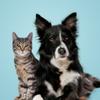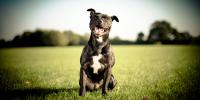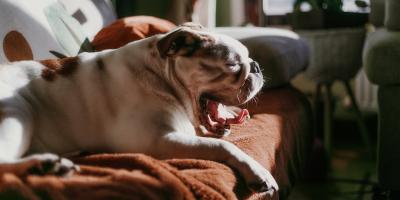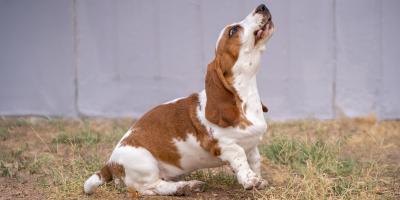Why Do Dogs Twitch in Their Sleep?


Dogs twitch in their sleep, but is it a doggy dream or a sign of something else? Here, we explain why dogs twitch and jerk when they sleep, what constitutes good dog sleep habits, and frequently asked questions about dog twitching.
Why Do Dogs Twitch and Jerk When They Sleep?
Dogs have sleep cycles similar to those of humans. They go through non-rapid eye movement (NREM) and rapid eye movement (REM) phases. Dog REM sleep is when most dreams occur. Like their owners, some dogs, when deep in REM sleep, might twitch or jerk. These muscle movements are usually harmless. Puppies and senior dogs can jerk or twitch more than adult dogs thanks to how their brains are developing or have developed.
Do Dogs Twitch Because of Dreams?
We know that dogs do in fact dream, and there is some scientific evidence that they dream about similar things that humans do, such as their day-to-day life and people, places, and things they are emotionally attached to. Dogs twitching in sleep or jerking when in REM sleep is normal. Dreaming happens during REM sleep, or the deepest state of sleep. For dogs, this happens in the first 20 minutes after falling asleep. The frequency or length of dreams can vary based on the dog’s size and breed. Larger breeds tend to have longer, less frequent dreams, while smaller breeds dream often, but for shorter lengths of time.
What is Normal Dog Twitching in Their Sleep?
If you’re trying to determine if your dog’s twitching in their sleep is normal, here’s what it might look like:
- Short, jerky movements that look like muscle spasms in their legs, tails, or faces
- Quiet vocalizations like barks and whimpers
- Rapid eye movement, even though their eyes are closed
- Normal breathing, although breathing can become shorter and quicker if they are actively dreaming
While your dog may sleep in a variety of positions in their dream state, these behaviors are fleeting and usually don’t affect sleep quality. There’s no need for you to wake your dog if they are twitching in their sleep.
Difference Between Twitching, Muscle Spasms, Sleep Tremors, and Seizures
Most of the time, twitching or jerking in sleep is normal behavior for dogs. Sometimes, though, more concerning things like muscle spasms, sleep tremors, and seizures can look similar to twitching. Here’s how to tell the difference:
- Twitching: Twitching is a normal, short movement a dog makes, usually while dreaming. It stops when a dog wakes up.
- Muscle Spasms: Dog muscle spasms can occur asleep or awake. They are involuntary and can cause pain and stiffness. They can happen when dogs are overexercised, dehydrated, or have an electrolyte imbalance.
- Sleep Tremors: Dog sleep tremors look similar to dog twitching or jerking, but they are more rhythmic. If the tremors are excessive, violent, or accompanied by other symptoms like vomiting, call your vet. Sleep tremors or shaking can mean that something is wrong, such as epilepsy or poisoning.
- Seizures: If your dog is violently and uncontrollably shaking, drooling, or loses consciousness or bladder control, call your veterinarian immediately.
What to Do if Your Dog is Twitching in Their Sleep More Than Usual
Dog twitching is nothing to be worried about, but if your dog starts twitching in their sleep more than usual, there are a few things you can do to help your dog’s vet:
- Document the twitching: If your dog is twitching more than usual, keep a log of how long it lasts, when it occurs, and the conditions under which it is happening.
- Check for other symptoms: Excessive twitching, like those during a seizure, is usually accompanied by other symptoms such as drooling and loss of consciousness.
- Write down any changes: Context is helpful to vets when assessing a medical condition. Write down any environmental, behavioral, or dietary changes.
- Take a video: If possible, record your dog twitching. They might not twitch at the doctor’s office, and it is helpful for the vet to see what kind of twitching is happening to get a handle on the full situation.
Good Dog Sleep Habits
Sleep habits is important for dogs. If they aren’t getting enough restorative sleep, they could have daytime behavior problems, yawn a lot, or catch up on sleep at inappropriate times. To help your dog sleep well:
- Provide a comfortable and consistent place to sleep, such as a dog bed.
- Establish a routine.
- Mentally and physically stimulate your dog throughout the day.
- Avoid large meals close to bedtime.
- Limit water close to bedtime so that they don’t have to use the bathroom at night.
- If your dog is anxious at night, try using calming scents.
Frequently Asked Questions About Dog Twitching
Why Does My Dog Shake Its Paws When Sleeping?
Paw shaking is a kind of twitching that dogs might do if they are in REM sleep. They could be dreaming about running or digging, which can cause their paws to twitch. It’s nothing to worry about, and it is a super cute dog behavior.
Why is My Dog Twitching and Breathing Fast in Sleep?
If your dog is breathing quickly and twitching during sleep, they are likely in deep, restorative sleep. Their brains are very active during REM sleep, and they could twitch more because of it. They could even be dreaming about something high-energy, like running. Dogs that breathe quickly while sleeping are healthy dogs. If they are panting or breathing quickly when awake, call your vet.
Why is My Dog Jolting While Awake?
Sudden jerking or twitching while awake might be an indicator of a deeper problem, such as muscle spasms, seizures, or neurological issues. Call your veterinarian if your dog is twitching, jerking, or jolting while awake.
Why is My Puppy Twitching in His Sleep?
Puppies can twitch in their sleep as part of a normal REM sleep cycle. They often twitch more than adult dogs because they are physically and mentally developing, including the part of their brain that controls muscle movement during sleep.
Conclusion
Dogs dream, and they sometimes twitch or jerk in their dreams. It’s a normal part of their sleep cycle. Call your vet if you think your dog is having a deeper issue related to twitching and jerking, such as doing it while awake, or if it’s accompanied by other symptoms.
For more expert tips on dog behavior, explore our other understanding dog articles.
Related articles

Reward Yourself with myPurina
Earn and redeem rewards for Purina products with the myPurina app.



